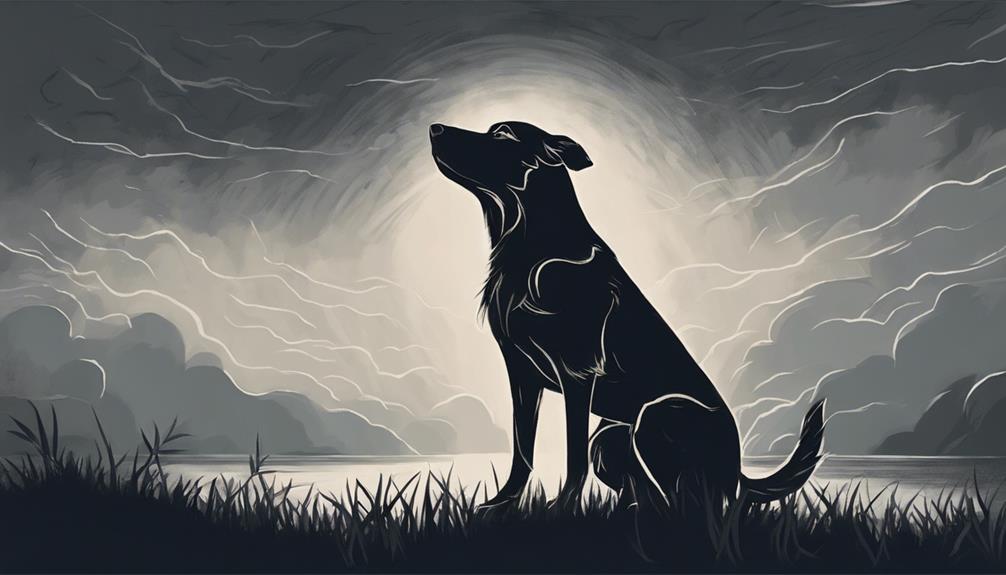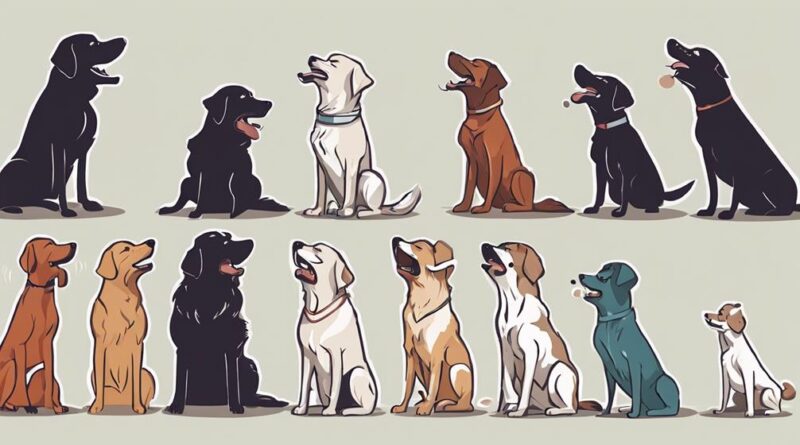5 Best Ways to Interpret Different Dog Howls
Have you ever wondered what secrets your furry companion's howls hold in the dead of night? Understanding the various nuances in your dog's vocalizations can provide invaluable insights into their emotions and needs.
From deciphering signs of loneliness to recognizing playful barks, each howl serves as a unique communication tool.
Stay tuned to discover the top five best ways to interpret different dog howls, and gain a deeper understanding of your canine companion's language.
Understanding Dog Howling Behavior
When deciphering dog howling behavior, pay attention to the pitch and duration of the howls. Dogs use vocal communication as a way to express their emotions, and howling is a key part of this. The pitch of a howl can indicate different emotions your dog is experiencing. High-pitched howls often signify excitement or anxiety, while low-pitched howls may indicate sadness or frustration. The duration of the howl is also essential to consider. Longer howls can suggest loneliness or a call for attention, while short, sharp howls may be a sign of alertness or warning.
Understanding dog howling behavior is crucial for interpreting your furry friend's feelings. By paying attention to the pitch and duration of their howls, you can gain insight into their current emotional state. Dogs have a wide range of vocal expressions, and each howl carries a unique message. By recognizing these cues, you can better understand your canine companion and strengthen your bond through improved communication.
Recognizing Loneliness in Dog Howls
To recognize loneliness in your dog's howls, observe for prolonged, plaintive pitches that may indicate a longing for companionship. When your furry friend is feeling lonely, their howls may sound more sorrowful and drawn out. Here are some key points to help you identify loneliness in your dog's howls:
- Subdued and Continuous: Listen for howls that are continuous, with minimal breaks in between. A lonely dog may keep howling in a more subdued tone, almost as if they're calling out for someone to return.
- Increased Frequency: Notice if your dog starts howling more frequently when left alone. This uptick in howling can be a sign of loneliness and a desire for attention and connection.
- Accompanied by Whining: Pay attention if the howling is accompanied by whining or pacing. These behaviors can be indicative of separation anxiety and a longing for companionship.
Addressing separation anxiety and recognizing attention-seeking behaviors are crucial steps in understanding and alleviating your dog's feelings of loneliness.
Identifying Playfulness in Dog Howls
If your dog's howls are energetic and interspersed with playful barks, they may be signaling their joy and excitement. Playful howls are often accompanied by wagging tails, bouncing movements, and an overall light-hearted demeanor. Understanding canine communication is essential in recognizing when your dog is engaging in joyful interactions through their howls.
When identifying playfulness in dog howls, pay attention to the pitch and rhythm of the vocalizations. Playful howls are typically higher-pitched and may have a musical quality to them, almost like a happy song. These howls are often short and quick, with pauses for playful barks or even playful growls.
During playfulness, dogs may also exhibit a play bow, where they lower their front legs while keeping their hind end up. This stance is a clear signal that your dog is in a playful mood and ready to engage. Keep in mind that playfulness in dog howls is a positive and enjoyable expression of your furry friend's emotions.
Deciphering Anxiety Through Dog Howls
Decipher signs of anxiety in your dog through their howls by noting changes in pitch, duration, and intensity of the vocalizations. When your furry friend is feeling anxious, their howls may convey stress signals that you can pick up on through careful observation.
Here are some communication cues to help you interpret your dog's anxiety:
- Pitch Changes: Anxious howls may have a higher pitch than usual, indicating discomfort or unease.
- Extended Duration: Longer howls can suggest heightened anxiety levels, as your dog tries to express their distress.
- Increased Intensity: Intensified howling, with louder or more frequent vocalizations, could be a clear indicator of your dog's anxiety.
Distinguishing Pain in Dog Howls
Noticing changes in your dog's howls can provide valuable insights into whether they might be experiencing pain. Dogs use vocal communication to express various emotions, including pain. When a dog is in pain, their howls may sound different from their regular vocalizations. These howls may be more prolonged, higher-pitched, or accompanied by whimpers and other signs of distress.
Paying attention to the context in which your dog is howling is crucial. If your dog usually howls when playing but suddenly starts howling while resting or eating, it could be a sign of discomfort. Additionally, observe your dog's body language for cues of emotional distress. Signs like pacing, licking a specific body part, or avoiding certain movements may indicate pain.
If you suspect that your dog's howls are related to pain, it's essential to consult with a veterinarian. They can conduct a thorough examination to identify the source of the discomfort and recommend appropriate treatment. Remember, your furry companion relies on you to interpret their vocalizations and address any potential issues promptly.
Interpreting Territorial Dog Howls
When identifying territorial dog howls, observe their pitch and frequency for clues to their protective behavior. Territorial howls are distinct in nature and can provide insight into your dog's mindset.
Here are some key points to help you interpret territorial dog howls effectively:
- Establishing boundaries: Territorial dog howls often serve as a way for your furry friend to establish boundaries and mark their territory. The howls may vary in intensity depending on the perceived threat to their space.
- Handling aggression: Pay attention to the level of aggression in the howls. Territorial howls can sometimes indicate a defensive stance, signaling that your dog is prepared to protect their territory if necessary.
- Protective instincts: Territorial dog howls stem from your pet's natural protective instincts. Understanding and respecting these instincts can help you create a harmonious environment while ensuring your dog feels secure in their space.
Unraveling Frustration in Dog Howls

To understand frustration in dog howls, pay close attention to the tone and duration of the vocalizations. Dogs express frustration through various stress indicators like high-pitched and repetitive howling. When your dog is frustrated, you may notice a more urgent and intense sound in their howls compared to other types of vocalizations. The duration of the howls can also give you insight into the level of frustration your dog is experiencing. Short, sharp bursts of howling may indicate momentary frustration, while prolonged and persistent howls could signal a deeper level of annoyance.
In addition to stress indicators, dogs use specific communication cues to convey their frustration through howling. Dogs may incorporate growling or whining into their howls when they're feeling frustrated. These additional vocalizations can help you better understand your dog's emotional state and address their needs promptly. By paying attention to both the tone and duration of your dog's howls, along with these communication cues, you can effectively unravel and address your furry friend's frustration.
Responding to Medical Concerns in Dog Howls
Listen carefully to your dog's howls as they can serve as important indicators of potential medical concerns. If your furry friend seems to be communicating distress through their vocalizations, it's crucial to pay attention and respond promptly to ensure their well-being. Here's how you can address medical issues based on your dog's howls:
- Emergency response: If your dog's howls suddenly become high-pitched or frantic, it could indicate an emergency situation such as choking, severe pain, or injury. In such cases, it's essential to act swiftly and seek immediate veterinary assistance to prevent any further harm.
- Vocalization analysis: Pay close attention to the frequency, intensity, and duration of your dog's howls. Changes in these aspects can provide valuable insights into their discomfort or pain levels. Consulting with a veterinarian for a thorough vocalization analysis can help pinpoint underlying medical issues that may be causing your dog's distress.
- Observation and monitoring: Keep a close eye on your dog's overall behavior and physical condition alongside their howling. Document any additional symptoms or changes in their routine to provide comprehensive information to the vet for a more accurate diagnosis and treatment plan.
Frequently Asked Questions
Can a Dog's Breed Affect the Way They Howl and the Reasons Behind It?
Different dog breeds howl in unique ways due to their genetic makeup. Some breeds, like hounds, are more prone to howling because of their history as hunting dogs.
Age can also influence howling behavior. Puppies may howl to communicate distress or loneliness, while older dogs might howl more due to cognitive decline or health issues.
Understanding breed differences and age-related factors can help you interpret your dog's howling more accurately.
How Can a Dog's Age Impact Their Howling Behavior?
As a dog ages, their howling frequency and patterns may change. Younger dogs often howl more frequently and in response to excitement or separation anxiety. In contrast, older dogs may howl less due to hearing loss or a decrease in energy.
Keep an eye on your pup's howling habits as they age, as it can indicate changes in their health or behavior that may need attention.
Are There Certain Environmental Factors That Can Trigger Excessive Howling in Dogs?
Certain environmental influences like loud noises, separation anxiety, and loneliness can trigger excessive howling in dogs. Breed differences also play a role in how sensitive a dog is to these triggers.
Understanding your dog's breed tendencies and providing a calm and comforting environment can help reduce excessive howling behaviors. Be mindful of your dog's surroundings and work on creating a peaceful atmosphere to address any howling concerns.
Can Training or Socialization Help Reduce Excessive Howling in Dogs?
Training techniques and behavior modification can help reduce excessive howling in dogs. By incorporating socialization benefits and behavioral therapy, you can address the root causes of the behavior.
Consistent training and positive reinforcement can teach your dog alternative ways to communicate and cope with triggers that may lead to excessive howling. Socialization can also help your dog feel more secure and less prone to anxiety-induced howling episodes.
Is There a Difference Between Howling and Barking in Terms of Communication and Meaning for Dogs?
When it comes to vocalization differences and canine emotions, understanding the nuances between howling and barking is crucial. Howling often signifies communication over long distances or expressing loneliness, while barking can convey excitement, alertness, or warning.
Conclusion
So next time your furry friend starts howling, pay attention to the tone and context to better understand what they're trying to communicate. By recognizing the different meanings behind their howls, you can respond appropriately and strengthen your bond with your dog.
Remember, interpreting your dog's howls is just one way to improve your communication and relationship with your pet. Keep listening and observing to deepen your understanding of your canine companion.
